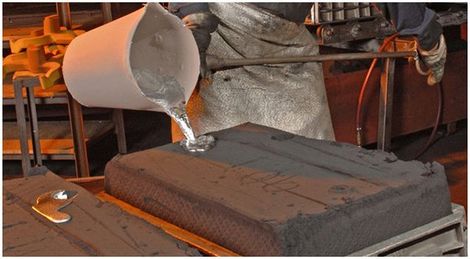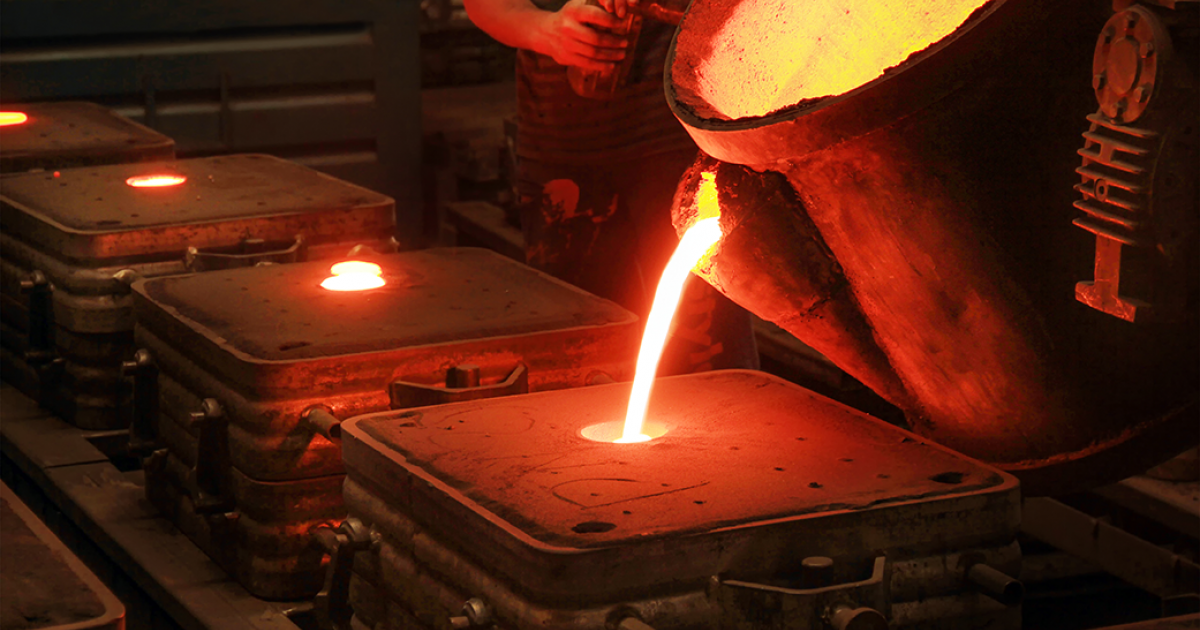Closer Look into How a Metal Foundry Operates
Wiki Article
All Concerning Metal Casting: How Foundries Deliver Top Quality and Precision in Manufacturing
Metal casting stands as a foundational procedure in production, where raw steels are changed into particular parts. Foundries employ different casting methods to accomplish preferred features and forms. Each strategy features its own set of benefits and limitations. Understanding these nuances is important for appreciating how quality and precision are kept throughout the procedure. The conversation ahead will discover the detailed dynamics of metal casting and its importance across multiple sectors.The Fundamentals of Metal Casting
Metal casting is an essential process in manufacturing that entails shaping liquified metal right into preferred kinds. This essential technique begins with the option of basic materials, typically numerous metal alloys, which are thawed in a furnace. As soon as the metal reaches the proper temperature level, it comes to be fluid and prepared for casting.The procedure needs a mold, usually made from sand, metal, or ceramic, which specifies the last shape of the actors object. As soon as the liquified metal is poured right into the mold, it cools down and strengthens, handling the mold and mildew's contours.
After cooling down, the casting is gotten rid of from the mold and mildew, and any type of necessary completing procedures, such as trimming or brightening, are conducted. This approach permits producers to create complicated shapes and parts with high precision and very little waste. Metal casting is commonly made use of throughout various sectors, from automotive to aerospace, emphasizing its importance in contemporary production.
Kinds Of Casting Approaches
While numerous casting methods exist, each strategy is and uses distinct benefits fit for various applications. Sand casting, one of one of the most typical techniques, utilizes sand as the mold material, enabling intricate designs and big components. Investment casting, understood for its precision, uses a wax pattern covered in ceramic, making it ideal for complicated geometries. Pass away casting, which entails forcing molten metal into mold and mildews under high pressure, is regularly used for mass manufacturing of little, detailed components. In addition, shell molding integrates sand and material to create thinner, much more exact mold and mildews, boosting surface finish. Another method, continuous casting, enables the production of long sizes of metal shapes, enhancing manufacturing procedures. Each of these methods plays a critical role in the metal casting industry, addressing details needs from manufacturing quantity to make intricacy, thus adding to the diversity of applications throughout numerous sectors.The Function of Foundries in Manufacturing
Foundries serve an important feature in the production landscape, as they transform raw steels into usable elements with various casting procedures. These facilities use a series of strategies to develop products that meet specific requirements, consequently guaranteeing quality and performance in manufacturing (Aluminum Casting). By making use of approaches such as sand casting, investment casting, and pass away casting, shops deal with varied markets, consisting of vehicle, aerospace, and building
Eventually, factories are integral to the manufacturing ecosystem, providing crucial components that support a wide array of markets and applications. Their precision and versatility drive efficiency in modern production.
Products Utilized in Metal Casting
The choice of materials used in metal casting is essential for achieving the wanted homes and performance of the final item. Various metals such as bronze, light weight aluminum, and iron are typically employed, each offering distinctive benefits. Aluminum is favored for its corrosion-resistant and light-weight high qualities, making it excellent for auto and aerospace applications. Iron, particularly cast iron, is known for its superb fluidness and toughness, ideal for hefty equipment and facilities parts. Bronze, with its superior wear resistance, is commonly made use of in marine settings.Furthermore, products such as silica sand are frequently made use of for mold production, providing a great balance between resilience and convenience of shaping. The choice of products additionally consists of additives like fluxes, which enhance the casting process by improving fluidness and lowering oxidation. Inevitably, the ideal option of these products substantially affects the effectiveness and quality of the casting process.
High quality Control in the Casting Process
Quality control in the casting process is important to ensure that last items satisfy sector requirements and specs. Different inspection methods are used to recognize defects and evaluate the stability of actors parts. Furthermore, adherence to developed criteria and certifications improves the dependability and efficiency of cast materials.Evaluation Techniques Employed
Preserving the integrity of actors metal parts depends heavily on numerous examination techniques. Foundries use visual inspections as a preliminary measure to recognize surface area issues, such as inclusions or splits. Non-destructive screening (NDT) approaches, consisting of ultrasonic screening and radiographic evaluation, are vital for detecting interior flaws without endangering the component's stability. Dimensional inspections utilizing calipers and coordinate measuring equipments confirm that parts meet defined tolerances. find out here now Furthermore, chemical analysis confirms that the alloy make-up aligns get redirected here with needed standards. These evaluation techniques collectively validate that the spreadings meet the necessary top quality and efficiency standards, ultimately reducing the risk of failing in their desired applications. Carrying out these extensive evaluations is essential for maintaining high criteria in metal casting manufacturing.Standards and Certifications
Criteria and qualifications play a vital role in the quality assurance of the casting process. Foundries stick to different international and industry-specific criteria, such as ISO 9001 and ASTM standards, ensuring consistency and integrity in their products. These criteria outline the necessary requirements for products, manufacturing methods, and testing treatments, adding to a more effective manufacturing process. Qualifications, such as AS9100 for aerospace applications, further highlight the value of quality control in specialized sectors. By obtaining these qualifications, factories demonstrate their commitment to excellence, reducing issues and improving client fulfillment. Normal audits and evaluations verify compliance, fostering continual renovation and technology within the market. Inevitably, adherence to developed criteria grows count on in between clients and makers.Innovations in Casting Modern Technology

3D Printing Integration
Incorporating 3D printing technology right into metal casting processes is changing the manufacturing landscape. This cutting-edge combination boosts the style and production of complicated geometries that conventional techniques battle to attain. By using additive production for creating mold and mildews and cores, factories can greatly minimize preparations and material waste. Additionally, 3D printing permits rapid prototyping, allowing suppliers to evaluate layouts quickly and efficiently, thus promoting iterative enhancements. This innovation likewise supports the production of light-weight parts, which are necessary in markets like aerospace and automotive. Therefore, the combination of 3D printing not only enhances operations but also raises the precision and top quality of actors metal products, noting a significant advancement in the industry.Automated Production Processes
The improvements in 3D printing have led the way for additional developments in automated manufacturing processes within metal casting. Foundries are significantly taking on robotics and automation to improve efficiency and precision. Automated systems improve the whole casting workflow, from mold development to putting and ending up. Smart sensors and real-time tracking allow for accurate control of temperatures and product circulation, lowering waste and enhancing high quality. Additionally, software application remedies promote far better style and simulation, enabling manufacturers to maximize processes prior to manufacturing begins. These computerized manufacturing processes not just reduce labor costs however additionally lessen human mistake, making sure regular output. As an outcome, the combination of advanced innovations in metal casting is revolutionizing manufacturing abilities and fulfilling the growing needs of different industries.Advanced Product Development
As industries demand greater performance and sustainability, improvements in material advancement for metal casting are emerging as an important emphasis. Designers and More about the author scientists are checking out brand-new alloys and compounds that boost mechanical residential properties while decreasing ecological impact. Developments consist of lightweight materials that maintain strength, enabling far better gas effectiveness in transportation applications. In addition, the unification of recycled materials is coming to be much more widespread, aligning with sustainability objectives. Advanced casting methods, such as 3D printing and precision molding, enable the production of complex geometries that traditional methods can not achieve. These developments not just enhance the capability of actors components however likewise improve production efficiency. Overall, the continual advancement of material scientific research drives the future of metal casting, fulfilling the needs of modern-day sectors.
Applications of Metal Casting Throughout Industries
Metal casting plays an important duty in numerous markets, as it permits the manufacturing of intricate shapes and high-quality parts with loved one performance - Aluminum Foundry. In the vehicle market, cast metals are important for creating engine blocks, transmission cases, and various other crucial parts that need toughness and precision. Aerospace markets use metal casting for elements like turbine blades and structural elements, where integrity is extremely importantFurthermore, machinery and equipment production gain from metal casting by producing equipments, real estates, and other detailed parts that enhance capability. The building industry additionally utilizes metal casting for building functions, structural assistances, and fittings, showcasing versatility.
Moreover, the clinical field relies on actors steels for medical instruments and implants, emphasizing the requirement for biocompatibility. In general, metal casting is a fundamental process across numerous markets, offering options that fulfill stringent quality standards and performance needs.
Frequently Asked Inquiries
What Precaution Are Absorbed Metal Casting Foundries?
In metal casting factories, safety and security measures include protective equipment, ventilation systems, normal tools maintenance, worker training, and emergency methods to alleviate dangers related to high temperature levels, hazardous products, and potential crashes during the casting procedure.Just How Do Foundries Handle Waste and Environmental Influence?
Foundries manage waste and environmental effect via reusing materials, carrying out purification systems for exhausts, and adhering to regulations - Metal Foundry. They also embrace sustainable methods, such as reducing power intake and making use of environmentally friendly substances in their proceduresWhat Are the Prices Linked With Metal Casting Procedures?
The prices connected with metal casting procedures consist of raw products, labor, tools upkeep, power usage, and waste administration. Furthermore, variations in market value and conformity with ecological laws can greatly influence total expenditures for factories.Exactly How Does Metal Casting Contrast to Other Manufacturing Methods?
Metal casting supplies unique advantages, such as complicated shapes and high material performance, compared to approaches like machining or marking. Nevertheless, it may involve much longer preparations and greater first prices, depending upon project specifications.
What Profession Opportunities Exist in the Metal Casting Industry?
The metal casting sector provides numerous occupation opportunities, consisting of factory management, procedure engineering, quality control, mold and mildew style, and machine procedure. Experts can also seek functions in research study and development, sales, and ecological wellness and security.Metal casting stands as a foundational process in production, where raw metals are transformed right into specific elements. Metal casting is a fundamental process in making that includes forming molten metal into wanted forms. An additional method, constant casting, makes it possible for the production of lengthy sizes of metal shapes, simplifying manufacturing procedures. The prices associated with metal casting processes consist of raw products, labor, tools maintenance, energy usage, and waste monitoring. The metal casting industry uses various occupation possibilities, including factory management, procedure design, quality assurance, mold style, and equipment procedure.
Report this wiki page